|
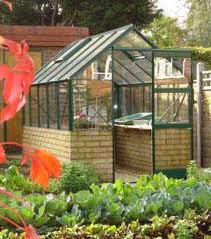
A
greenhouse is a closed construction designed to suppress air convection
while remaining transparent to natural sources of light so that the
plants within can photosynthesize. Traditionally the cladding was glass
(hence glasshouse) but transparent plastic is now often used. The
suppression of air convection means heat from the sun and internal
furnaces can be better retained, thus enabling plants to be grown out of
season and in hostile colder regions.

Greenhouses
exploit the fact that air has a great capacity for thermal
convection - the movement of masses of warmer gas molecules to
cooler regions. We experience the forces of this thermal convection as
wind (breezes, gusts, gales etc) and these movements of air moderate
temperatures on Earth.
By
comparison air has a small capacity for thermal
conduction – the direct movement of heat between atoms. Hence
stilled air is a relatively effective thermal insulator compared to most
common materials.
There
is a common misconception that greenhouses retain heat because the glass
lets sunlight through, the sunlight hits the soil and other contents and
is transformed into longer wave infrared radiation, which cannot pass so
easily back out through the glass. However polyethylene is almost as
transparent to thermal infrared radiation as it is to solar radiation
and polyethylene greenhouses also retain heat.
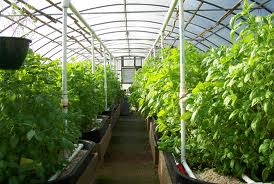
Greenhouses
work primarily because their design enables us to exploit the thermal
properties of air and thus control and suppress thermal convection. It
is valuable to understand this for a number of very important reasons:
We can improve our horticulture.
We can improve our design and use of insulated dwellings.
We can better understand how our atmosphere works.
We can enjoy a greater state of science and harmony with all.
Atmosphere
= greenhouse
The
endemic symbolization of the atmosphere as a greenhouse reveals a
profound denial of stewardship/change that puts humanity at peril.
Though
the general principles for building greenhouses had been known for
millennia, the physicist Horace-Benedict
de Saussure is credited with constructing the first solar oven in
1767 using an insulated box with three layers of glass.
The
physicist-mathematical genius, Joseph
Fourier, knew of the work of de Saussure. His experiences of the
thermal extremes of the Sahara Desert also provided him with insight of
the powerful role of the atmosphere on thermal balances. In 1827 he
contrasted the elevated temperature in the sealed insulated box with
that of the turbulent convecting atmosphere and attempted a mathematical
explanation. It is from this work that he is popularly attributed with
discovering the “greenhouse effect” .
The
greenhouse effect symbol is the notion that air is largely
transparent to visible light while being relatively opaque to infrared
and that without its envelope of air, then Earth’s surface would be
about -18ºC i.e. 33ºC cooler on average. We now know that a group of
trace gases with powerful capacities to retain thermal energy are
responsible for the current sustaining 15ºC average.
It is common to symbolise them as greenhouse gases - this
evocation of greenhouses is doubly unhelpful because it obscures their
trace nature and the powers of leverage..
While
it is probably incorrect to attribute Fourier with symbolizing the
atmosphere as a greenhouse the image resonated deeply in the culture of
the “Industrial Revolution”.
In
Fourier’s time greenhouses were already a symbol of great social
prestige and industrial power. European manors competed to grow
rare flowers and foods out of season. This use of the greenhouse
symbol expanded in profound ways to express national pride, global
aspirations and religious visions.
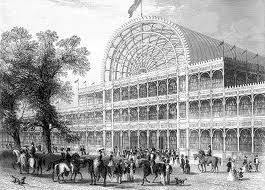
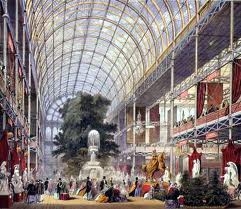
The Crystal Palace Britain built 1851
For
instance, the Great
Exhibition of 1851, was designed to display Great Britain’s
industrial might and reinforce the image of humans (Britons in
particular) fulfilling ancient Biblical
and other
incantations that Man is ordained by God to live in dominion over
all other creatures and the resources of Earth. (The dominion symbol was
largely stripped of its association with conservation and associated
with the right to control and exploit the resources of Earth.) This
dominion over all was symbolized by housing the Great Exhibition in a
giant greenhouse (The Crystal Palace).
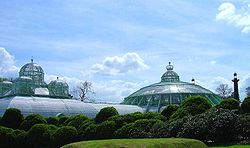
King Leapold's greenhouse Laeken
Belgium built 1874-
The
greenhouse symbol soon became the ultimate expression of the
religions that enabled the Industrial Revolution with its fundamental
belief that humans can exploit engineer all elements of our planet at
will. Thus it is now endemic for climate experts, teachers and the media
to evoke images of Earth encased in a greenhouse in myriad ways.
These include preaching of greenhouse gases and greenhouse
effects in a greenhouse world.
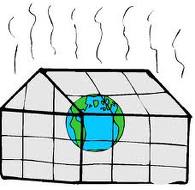
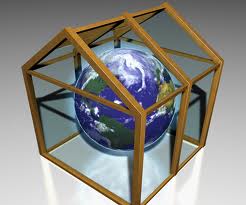

Samples of greenhouse earth icon from Internet
- posters of this symbol commonly adorn our school walls.
This
symbolization of Earth’s atmosphere as a greenhouse is a profound
denial of change because our atmosphere is very dynamic and organic
structure, characterized by a powerful capacity to transfer thermal
energy by convection. Greenhouses are the converse. This denial enables
maladaptive behaviour on scale. As
a result our impact on the thermal balances that sustain humanity may
well induce changes to our climate characterized by enhanced convection
with more extreme weather events. We deny this change out our peril.
The
greenhouse earth icon is particularly convenient for the egos of
those who live in temperate zones and those in tropical areas dependent
on air conditioning - it has comfortable subliminal associations with control, calm
and personal comfort levels maintained at our will.
It
is also a profound denial of stewardship for it replaces the image of
humans as part of a dynamic, organic structure with an image of humans
transcending atmospheric processes and being able to manipulate them at
will. This disconnection enables a dangerous denial of stewardship
of our actions that also puts humanity at grave risk.
Summary
Conserve the potential of the greenhouse
symbol by only associating it with human constructions. Thus our
children will better understand the thermal properties of air and be
more able to design buildings, clothing and other products using all
manner of material in ways that exploit those properties while living in
harmony with Earth’s climate. Enjoy
the rewards of being a conservator of the potential of our greatest
symbols.
Page last updated:
Aug 2010
TOP
|